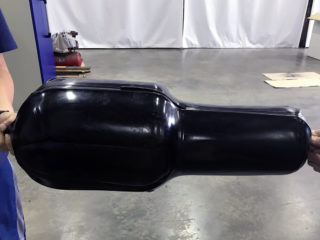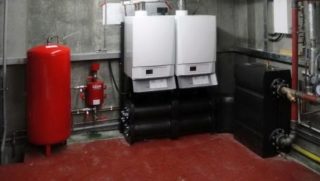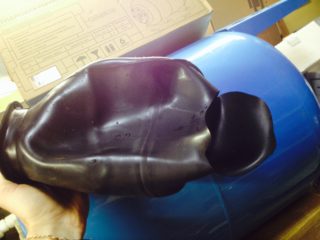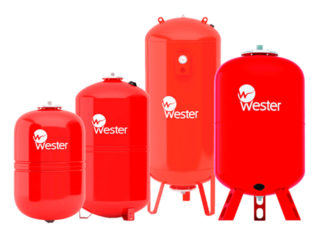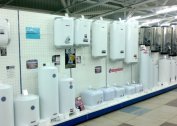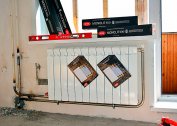When heating the coolant in closed heating systems, increased pressure is created. The liquid at a temperature of 90 ° C increases in volume by 3.55%. So that an excess amount of coolant does not spoil the radiators or pipes, a membrane tank for heating is installed. The safety design of the metal tank and flexible membrane accepts excess water, returning pressure readings to normal.
The device and principle of operation of the membrane tank
The expansion tank is a sealed metal container, the inner part of which is divided into two parts by an elastic membrane. One compartment is filled with air, the second will receive water during expansion. The casing of the tank is made of steel. Metal protects against corrosion by powder coating. According to the type of heating networks, the devices are divided into two groups:
- open;
- closed.
The open expansion tank must be at the highest point of the circuit. It is made of steel, the most common is a rectangular shape. The tank serves to drain excess fluid and air dissolved in it. Its design is very simple - two nozzles are cut into a metal container with a lid - for the intake and removal of water. The tank is often installed in the attic. In a cold room it must be insulated with foam. The advantage of an open design is its simple operation and low cost.
Membrane expansion tanks for closed heating systems must be tight. The steel tank is designed for long-term operation. Its working part is an elastic membrane. It is made of special heat-resistant rubber. Depending on the type of tank, a balloon or diaphragm type membrane is used.
Principle of operation
In water heating systems, liquid coolant circulates. When heated, it expands. Surplus through the connecting pipe enters the membrane tank. Elastic rubber is stretched, one compartment is filled with liquid, and in the second, air is compressed. After cooling the water in the circuit, the pressure decreases. Under the action of compressed air, the membrane straightens and pushes the liquid back into the system.
During movement, the liquid does not come into contact with air. This reduces the likelihood of corrosion.
Types of membrane tanks
In order for the heating system to work with maximum efficiency, it is important to choose the membrane tank correctly.
Fixed
A fixed membrane design is recommended for small heating systems. In such circuits, the pressure is relatively stable and there are no sharp jumps. The flexible element is rigidly fixed and cannot be removed for replacement in the event of a malfunction. The advantage of the option is the low price.
Replaceable diaphragm flange
A feature of the design of the tank is the fixation of the balloon-type membrane on the neck using a flange. The bolt mount allows you to reliably hold the rubber part during operation. If it breaks, you can remove the part and replace it with a new one. The possibility of repair extends the life of an expensive tank.
Advantages and disadvantages
The main advantage of the equipment is the prevention of leaks and other emergency situations that occur during pressure surges.Tanks are needed in long circuits. They contain a significant amount of water, which, when expanded, creates an increased load on the joints, radiators and pipes.
Advantages of equipment:
- air does not enter the line;
- the equipment is designed for water of any quality;
- no evaporation of liquid;
- emergency pressure increase is prevented;
- installation is possible anywhere;
- system maintenance is simplified; regular replenishment of the coolant is not required.
The disadvantages include heat loss and the relatively high cost of membrane tanks compared to open tanks.
Volume calculation
The parameters of the tank should allow to prevent the increase in pressure when heating the coolant. For an approximate calculation of a system with a capacity of up to 150 l, you can use the formula: tank volume - 10% of the system volume. In the case of using antifreeze, the parameter increases to 15%. For calculations, you need the capacity of the circuit. You can find out the parameter by the water meter in the process of filling the system. It is also calculated by adding up the volume of all nodes, pipes, radiators and the boiler. There are online calculators for calculating.
A more accurate value will give a calculation by the formula: V = V1 x Bt / (1- (Pmin / Pmax))where:
- V - tank volume;
- V1 - the volume of fluid in the circuit;
- Bt - coefficient of thermal expansion of the coolant, is according to the table;
- Pmin - factory pressure in the tank;
- Pmax - the maximum pressure in the system, is determined at the time the safety valve is activated.
Correctly selected volume of the expansion tank helps to extend the life of the heating system.
Requirements and recommendations for installing a membrane tank
Installation of equipment can be done independently, following the instructions. When working, adhere to the installation requirements:
- The first step is choosing a place. It is necessary to provide free access to the tank for maintenance. A good place is the section of the return line between the pump and the boiler.
- For the safety of a closed circuit, the installation of a safety valve, air vent, pressure gauge and thermometer will be required.
- In front of the inlet pipe, a drainage valve is installed to drain the water from the tank.
- Filters must not be installed in the area connecting the tank and the heating system.
- Before connecting the equipment, check the pressure of the gas space. If necessary, pump air.
- The tank should not be placed in a room with subzero temperature.
The tank is securely fixed to the wall, while it should not be subjected to additional load. High-volume models are mounted on the floor. We recommend a wiring diagram with the location of the inlet pipe at the bottom. Experts advise to make a detachable connection of the pipe and the drain valve in front of it. If necessary, the expansion tank is easily dismantled.
The manufacturer indicates the requirements for the amount of antifreeze in the composition of the coolant. The declared proportions must not be exceeded.
Rules for choosing equipment
The main characteristics of the membrane tank, which are oriented upon purchase:
- volume;
- maximum pressure;
- membrane and body material;
- working temperature.
These criteria will ensure the reliability of heating. Insufficient or excessive volume of the tank will not allow to establish normal pressure in the circuit. The type and material of the membrane and housing affects the life of the equipment. High-quality rubber withstands a large number of expansion and compression cycles. To prevent the housing from corroding, it must have a protective coating. It is worth considering the dimensions of the product and consider the installation site. Specialists advise buying products from well-known manufacturers.The low cost of production is often an indicator of the use of low grade materials.
Possible breakdowns
During equipment operation, owners are advised to inspect the housing for leaks and damage every six months. It is also necessary to measure the pressure in the gas chamber. The condition of the membrane is checked once every 2 years. In case of prolonged absence of operation, water is drained from the tank.
Common Malfunctions:
- Pressure drop in the gas compartment - it is necessary to pump air through the nipple using a pump.
- Damage to the housing - mechanical stress or corrosion can cause cracking. You can restore the tightness of the container in the service center.
- Leaking air valve - rubber may crack due to high loads and hot water. It is better to timely replace the damaged part.
You can repair the equipment on your own. To replace the membrane, you will need to drain the water, remove the container and relieve pressure. Then unscrew the bolts of the flange holding the rubber part. The old membrane is removed, replaced with a new one. All procedures are carried out in reverse order.
Popular models
The Russian brand Wester produces membrane tanks for cold and hot water supply, as well as heating. The WRV series is designed to compensate for expansion of the coolant. It included models of various capacities - from 8 to 10,000 liters. The body of the product is painted red.
Wester WRV 50
The device is used in closed heating systems. Its volume is 50 liters. vertical arrangement of the case, floor mounting. The model is made of durable carbon steel. The membrane is made of food-grade synthetic rubber. It is interchangeable, a flange on the neck of the tank allows you to put and fix a new elastic part. Designed for pressure up to 5 bar.
Wester WRV 200 top
Membrane tanks for heating Wester wrv200 top are made of complex steel. For separation of the inner chamber, heat-resistant elastic rubber EPDM is used. The part is interchangeable. Operating temperature range from -10 to + 100 ° C. The design withstands pressure up to 10 bar, its volume is 200 liters. Outdoor seating.
The expansion tank is a simple in design but functional part of the heating system. Prevent damage caused by a sharp increase in pressure. Its installation will ensure safe and stable operation of all work nodes.


